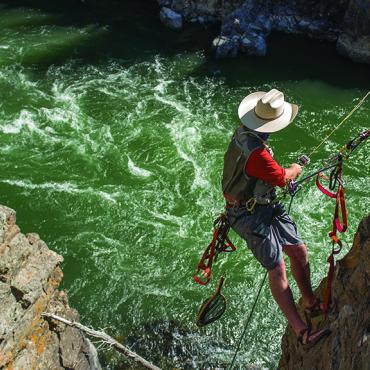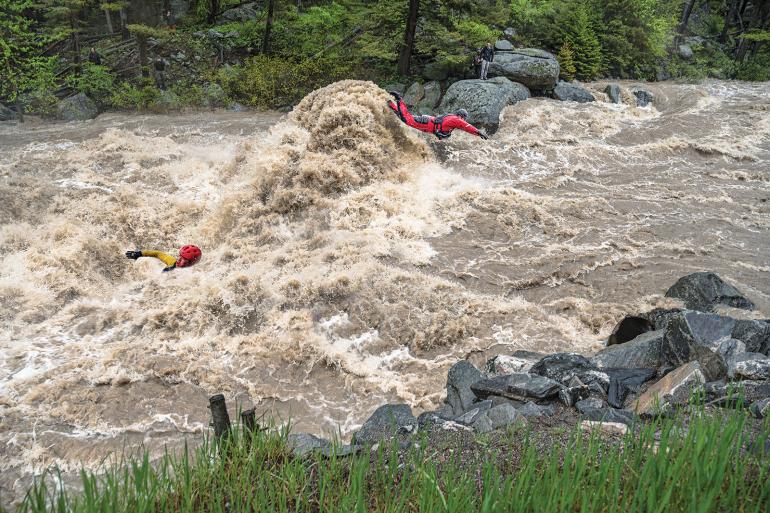A Foob's Errand
Swimming against the current.
When Gardiner resident Norm Aldude saw a body struggling in the high-water torrent of Boxcar Rapid in the Yellowstone River last spring, his instinct was to save the swimmer. Aldude grabbed his throw-rope and prepared to toss it, but just as he was about to let fly, a group of onlookers called him off.
“No way!” one woman called. “He’s got this!”
“Just wait,” a man yelled from his kayak. “Seven more strokes and he’ll be there!”
Against every reflex in his body, Aldude held off and looked on, dreading what might happen next. Then, with a sudden, convulsive thrust, the man launched out of the water, diving up and out of the hole that held him. When he landed headfirst in the glassy tongue above the rapid, he swam easily to shore to a cheering crowd, phones in-hand to capture the moment.
“It was like a dolphin rising from the sea,” Aldude recalled. “I couldn’t believe my eyes. I didn’t know whether to clap or toss him a salted herring.”
The man in the rapid was Sal Mahn, a former triathlete from Astoria, Oregon, and the last thing he needed was a rescue. Not only was Mahn capable of getting out of the surging whitewater safely, but he was there by design—participating in a new activity called “foobing.” Some say the sport was inspired by Lewis & Clark’s pilgrimage up the Missouri River in 1803. Others say it was inspired by three Bridger lifties who watched a sockeye-salmon documentary while hotboxing the midway hut. Others still insist that it’s nothing more than the latest offshoot of the Bozeman fitness-freak phenomenon. Whatever its true inspiration, the basis is simple: find a rapid; swim up it. The bigger the feature, the more stream cred for the swimmer.
The ingredients of a successful foob are simple. Strength and endurance are at the top of the list, along with water smarts, a reliable butterfly stroke, and resistance to giardia.
According to Mahn, the sport’s name is a play on the kayaking term “boof,” which means to launch over drops. “Swimming up rapids is basically reverse boofing,” Mahn says. “Not to be confused with barfing, which foobing has caused me to do many times.”
Now you may be thinking: “Swimming upstream through rapids? How is that even possible?” Turns out, with the right body position and a keen sense of delusion, it’s not only possible, but effective. The original idea was to hop between calmer pockets of water, ferrying quickly across swifter sections, spending a minimal amount of time in the rushing current. But, as the sport has evolved, foobers are making a point of running the meat.
“It’s like anything,” Mahn explains. “One day, we’re celebrating a climber summitting El Cap in a week; the next, someone’s nailing it in three hours without ropes. Same goes for foobing.”
But just because the sport is taking off doesn’t mean the barrier to entry isn’t high. After all, to foob means to go up against thousands of gallons of raging water that’s pushing, pulling, and ripping you away from your intended direction—similar to exiting Target as the doors open for a Yeti cooler sale. Your average Joe loses that battle 99 times out of 100. Still, people are jumping into the sport at alarming rates, even folks new to whitewater. A 2023 study reported that 35 percent of foobers had never even rafted before picking up the sport, while 14 percent claimed to have never swum without a pool noodle. “You’ll see kids who know how to move upstream better than they can downstream,” Mahn notes. “Which is kinda scary, considering the consequences of getting swept through a gnarly rapid.”
The ingredients of a successful foob are simple. Strength and endurance are at the top of the list, along with water smarts, a reliable butterfly stroke, and resistance to giardia. It’s also imperative to avoid salmon-colored swimwear, so as not to set off the natural instincts of bears. Finally comes the capacity to inhale copious amounts of water, as well as marijuana. “It’s actually how we train,” Mahn points out between puffs of a cigar-sized joint. “Gotta have tough lungs and a sound mind in the foob game. Plus, the penalty for a rescue is a gravity bong hit.”
Foobers can be found all over Montana, stroking and smoking their merry way up the river. Among them exists everyone from recreational swimmers to athletes going for fastest-known-foobs (FKF), a growing category on Strava. Speaking of records, Mahn notched the first ascent of the Mad Mile last spring. However, some foobers are contesting it because he bolted House Rock—using the boulder as an anchor to self-belay through the hole. “It was for safety only,” Mahn says. “I didn’t actually slip or pull on the rope for assistance.”
Local resident Sal Mahn notched the first ascent of the Mad Mile last spring. However, some foobers are contesting it because he bolted House Rock—using the boulder as an anchor to self-belay through the hole.
Doesn’t matter, say the purists, or pura-foobers, as they’re called. “Swim it free-solo or don’t swim it at all,” @SwimFreeOrDie declared on Instagram, typing 12 thumbs-down and six poo-faces on Mahn’s triumphant post. “Mahn’s no squid,” the scrupulous swimmer continued. “I heard he used a backpack trolling motor to get through Hilarity Hole.”
As the sport gains popularity and the rules and etiquette evolve, more dilemmas are popping up. For instance, river right-of-way has always gone to the downstream party, but with an increasing number of foobers hitting the water, that ethic has come into question.
“If I’m committed to a rapid and all the sudden a bunch of foo-foos, or whatever you call them, dive in, I can’t just anchor up,” local fishing guide Eddie Owte laments. “What are they doing going upstream anyway? Spawning? And what if one of my clients snags one? I’ll be damned if I’m forced to land a human. Every time I see ’em I keep thinkin’ about how in California they have Baywatch, but here in Montana, we have Dumbasswatch. They’re rude, entitled, and they smell like roe. They’re a disgrace to our rivers!”
But Mahn maintains that foobers are committed to fostering healthy relationships both on and off the river. “It’s part of the shared-use ethic of Montana public land and water,” he says. “There’s no reason we can’t all get along. If Owte wants to smoke a blunt with me, I’d happily oblige.”
While conflicts might be popping up on the water like flotsam from an overturned raft, foobing seems like it’s here to stay. This spring, if you see Speedo-clad swimmers struggling in whitewater rapids, cheer them on and offer support—they might just be venturing into uncharted territory.
For more info, or to learn upstream-swimming tips, tricks, and techniques, visit foobing.org.












